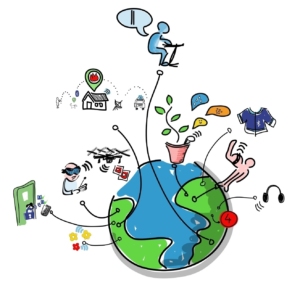
In 2016 IoT(Internet of Things) is not an unfamiliar term: Amazon Echo TV commercial airs on prime time. You can find Nest Protect (smoke alarm) easily at an end aisle of Home Depot. Even if there will be some challenges for IoT to be more mature, as smartphones prevailed our lives in a flash, IoT devices will do.
In the era of IoT, UX designers will work less on 2D screens. UX designers should focus on not only what is happening on two-dimensional planes, but also hardware and the system itself. In UX Magazine, Claire Rowland, independent product design and UX research/strategy consultant for the Internet of Things (IoT), said, “Designing for the Internet of Things (IoT) raises all the challenges of cross-platform design, and more. An obvious difference is the much wider variety of device form factors, many without screens.” Kelly Franznick, founder and chief experience officer at Blink UX in Seattle said, “They(UX designers) need to up their game so they’re as familiar with designing systems that aren’t screen-based.” He mentioned that UX designers may deal with physical models instead of computer-based prototypes, and also emphasized that UX designers will be familiar with tools like Arduino, an open-source a hardware/software package that allows users to build physical devices. In other words, so far UX designers have engaged in user experiences in mobile screen or web pages, but in IoT devices, understanding hardware is essential.
Oftentimes in IoT, the hardware is the user experience. The sensors, processors, and communication modules inside the device determine its purpose and how the user will interact with it. If a device fails to have the right sensors, no amount of pretty design or software will save it. (Alex Brisbourne, 2015) Unlike mobile devices or websites, display area is very limited or sometimes omitted in IoT devices. It’s like each hardware component represents what icons and typography play roles in conventional digital devices.
Unlike mobile phones or internet websites, IoT devices should consider user experience design at the beginning of the development process. For example, the 2nd generation Amazon Echo Dot has no screen at all. (See image below) It consists or four physical buttons, led lights, microphones, speakers, and USB and headset port. User experience of Echo Dot is determined solely from its hardware. Not many years ago ‘accessories’ of computers or mobile devices tend to depend on engineers or industrial designers. However, what we considered as ‘accessories’ equip with connectivity and is regarded as stand-alone devices, which contain complex functions in one device.

Since smartphones and personal computer interfaces are pretty ripened, recently many user experience design tend to focus on better experiences on the devices. However, concepts of UX design can be reinterpreted in IoT devices. User experience design is not limited to software, but it’s time for UX designers to enhance hardware user experiences.
Reference
https://uxmag.com/articles/whats-different-about-user-experience-design-for-the-internet-of-things
http://insights.dice.com/2015/10/08/the-internet-of-things-will-change-ux-design/
https://www.sitepoint.com/unique-ux-challenges-internet-of-things/